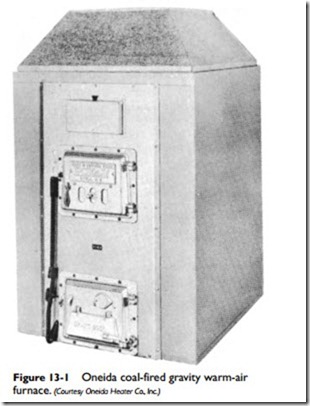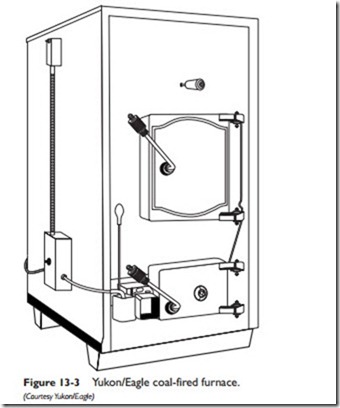Coal and wood furnaces burn solid fuels. The former burns coal or coke; the latter, various types of wood. Solid-fuel forced-warm-air furnaces are rated in accordance with formulas provided by the former National Warm Air Heating and Air Conditioning Association (now the Air Conditioning Contractors of America). Check the latest edition of the publication Commercial Standard for Solid-Fuel Burning Forced Air Furnaces. Some solid-fuel furnaces are designed to burn coal in combination with one or more other fuels, such as gas, oil, or wood (see Multi-Fuel Furnaces in this chapter).
The operating principle of coal, wood, or multi-fuel furnaces is relatively simple. The combustion process takes place in a sealed firebox located inside the furnace cabinet. A blower forces the heated air over an exchanger and then through the ducts to the living areas inside the house or building. Automatic controls are used to control its safe operation.
Coal Furnaces
Coal furnaces are either hand fired or fired with a coal stoker. A stoker is an automatic coal feeding device that carries the coal from the storage bin to the furnace as needed.
Early coal furnace models were gravity-feed types (Figure 13-1). The heat rose from the furnace through registers in the floor. No fan or blower was used to force the heated air through ducts. Later furnace models were equipped with blowers so that they could be used in forced-warm-air heating systems (Figure 13-2). The com- pact design of a modern coal furnace is illustrated in Figure 13-3.
Sizing Requirements
The first step in planning a heating system is to calculate the maximum heat loss and gain for the structure. This should be done in accordance with procedures described in the manuals of the Air Conditioning Contractors of America (e.g., Manual J, Residential Load Calculation) or by a comparable method (see Chapter 4 in this volume). This is very important, because the data will be used
to determine the size (capacity) of the furnace selected for the installation.
Location and Clearance
A coal furnace should be located a safe distance from any combustible materials. Consult the local codes and regulations for the required clearances.
Never obstruct the front of the furnace. Access must be provided to the fire and ashpit doors in order to operate the furnace.
A centralized location for the furnace usually results in the best operating characteristics, because long supply ducts and the heat loss associated with them are eliminated.
Figure 13-2 Oneida coal-fired forced-warm-air furnace.
Installation Recommendations
Make certain you have familiarized yourself with all local codes
and regulations that govern the installation of coal furnaces and coal stokers. Local codes and regulations take precedence over national standards. See Installation, Operating and Maintenance Instructions for Coal, Wood, and Multi-Fuel Furnaces in this chapter for additional information.
Duct Connections
The furnace supply plenum contains air at very high temperatures.
Because of these high temperatures, make certain there are safe clearances between the ductwork and any combustibles (including wall and ceiling materials). Check the furnace manufacturer’s recommendations.
Note
The same fire prevention precautions should also be taken for combustible materials near air conditioning and evaporator coils.
Detailed information concerning the installation of an air-duct sys- tem is contained in the following two publications of the National Fire Protection Association:
1. Installation of Air Conditioning and Ventilating Systems of Other Than Residence Type (NFPA No. 90A).
2. Residence Type Warm Air Heating and Air Conditioning Systems (NFPA No. 90B).
Additional information about duct connections can be found in Chapter 7 of Volume 2 (“Ducts and Duct Systems”). The comments in Chapter 11, “Gas Furnaces” about furnace duct connections and air distribution ducts also apply to ducts used with coal-fired forced-warm-air furnaces.


